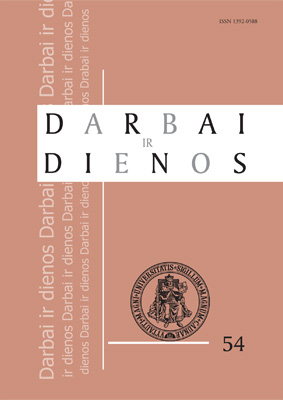Hedging Devices in English and Lithuanian Linguistic Research Articles
Hedging Devices in English and Lithuanian Linguistic Research Articles
Author(s): Violeta Kalėdaitė, Jūrata PieczulisSubject(s): Cultural Essay, Political Essay, Societal Essay
Published by: Vytauto Didžiojo Universitetas
Keywords: sąšvelnis; hedging devices; English; Lithuanian linguistic; research; Anglija; Lietuva; kalbotyra
Summary/Abstract: The corpus analysis has revealed that the English RAs, as compared to the Lithuanian RAs, show a greater use of hedges in general: 130 hedges were identified in the English RAs, while in the Lithuanian RAs 84 instances were found. Moreover, English authors have demonstrated greater variation in types of hedging devices. Even though the analyzed corpus of data was not big, our findings are in line with the results of Šinkūnienė’s study (2008). Our main focus, however, was analysis and description of one category of hedges, that of adverbs, which in our data ranked as the second most frequent group of hedges. Adverbs as hedging devices were first classified according to the semantic types into probability adverbs, adverbs of indefinite frequency, adverbs of indefinite degree, and approximative adverbs. These categories were established by earlier research for English, and the taxonomy of Lithuanian adverbs was performed following the same categories. The numbers of adverbs as hedging devices in the two languages can be said to differ along both parameters, i.e. types and tokens. The English RAs showed 46 occurrences of 16 different types, while the respective numbers in the Lithuanian RAs were 31 instances of only 6 different items. As regards their function, adverbs were mainly used either to reduce or to strengthen the force of the proposition, to boost the degree of probability; they also modified the neighbouring linguistic items, such as numerical expressions. Straipsnyje aptariamas anglų kalboje gana plačiai nagrinėtas reiškinys, kuris įvardijamas terminais „hedge“ arba „hedging“. Šių terminų vertimas į lietuvių kalbą dar nėra galutinai nusistovėjęs, o mokslinėje literatūroje vartojami terminai: „sąšvelnis“, „pasakymą švelninančios priemonės“, „apsidraudimas“ arba „modalinimas“ – perteikia šio reiškinio esmę, t. y. įvairių kalbinių priemonių naudojimą norint sušvelninti propozicinio turinio kategoriškumą arba išreikšti paties kalbėtojo / autoriaus požiūrį į išsakytus teiginius. Tyrimui taikomas kontrastyvinis metodas. Lyginamasis tekstynas sudarytas iš penkiolikos straipsnių įvairiais kalbotyros klausimais, iš kurių šeši anglų kalba (27 365 žodžiai), o devyni lietuvių kalba (28 315 žodžių). Sąšvelnių kokybinė ir kiekybinė analizė parodė, kad anglų kalba parašytuose straipsniuose sąšvelniai vartojami dažniau nei lietuviškuose. Angliškoje tekstyno dalyje rasta 180, o lietuviškoje 84 sąšvelniai. Be to, angliškuose straipsniuose sąšvelnių įvairovė kur kas didesnė tiek reiškiant autoriaus poziciją, tiek panaudotų kategorijų skaičiumi, tiek atliekamomis funkcijomis. Itin gausiai vartojami modaliniai veiksmažodžiai.
Journal: Darbai ir dienos
- Issue Year: 2010
- Issue No: 54
- Page Range: 227-237
- Page Count: 11
- Language: English

